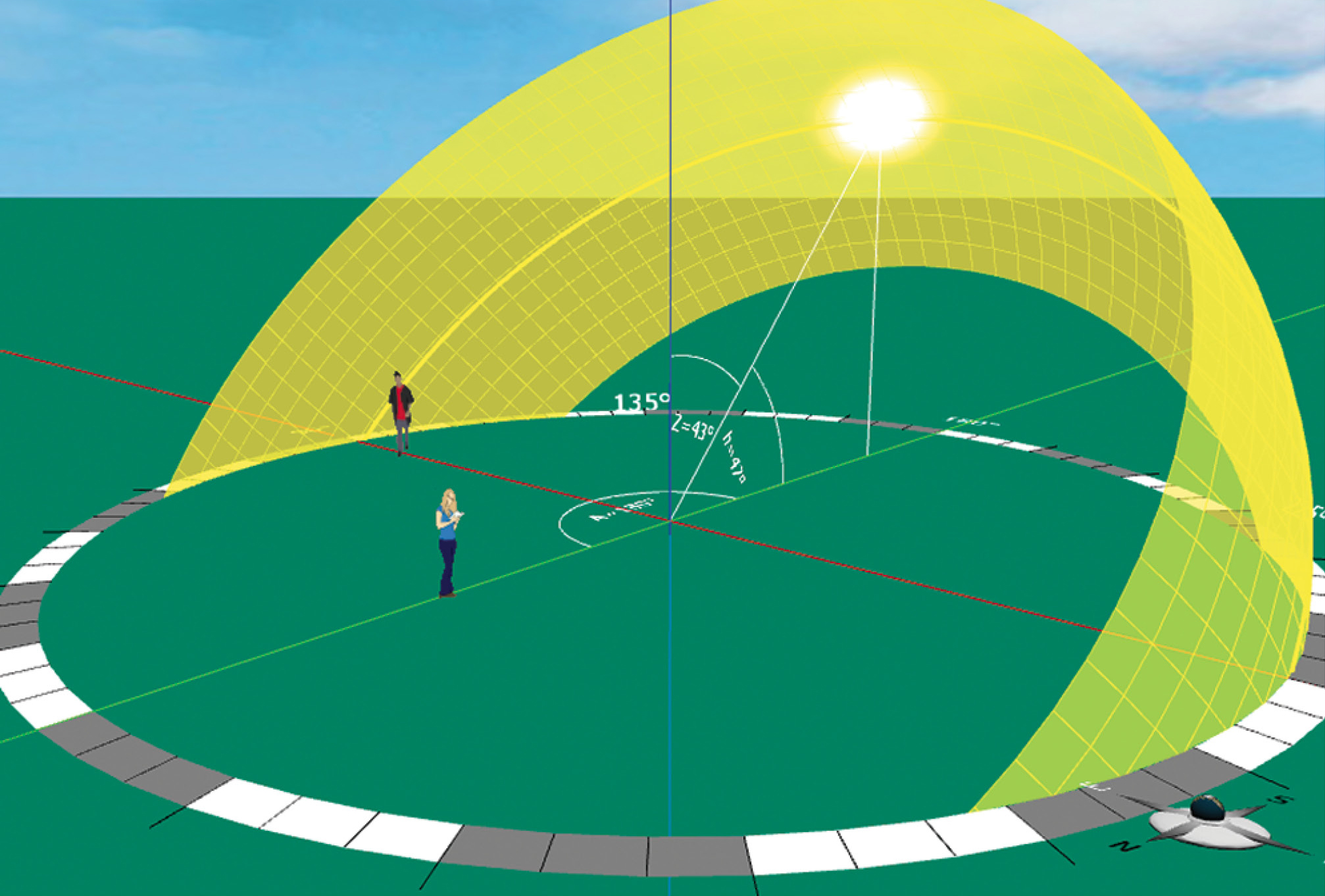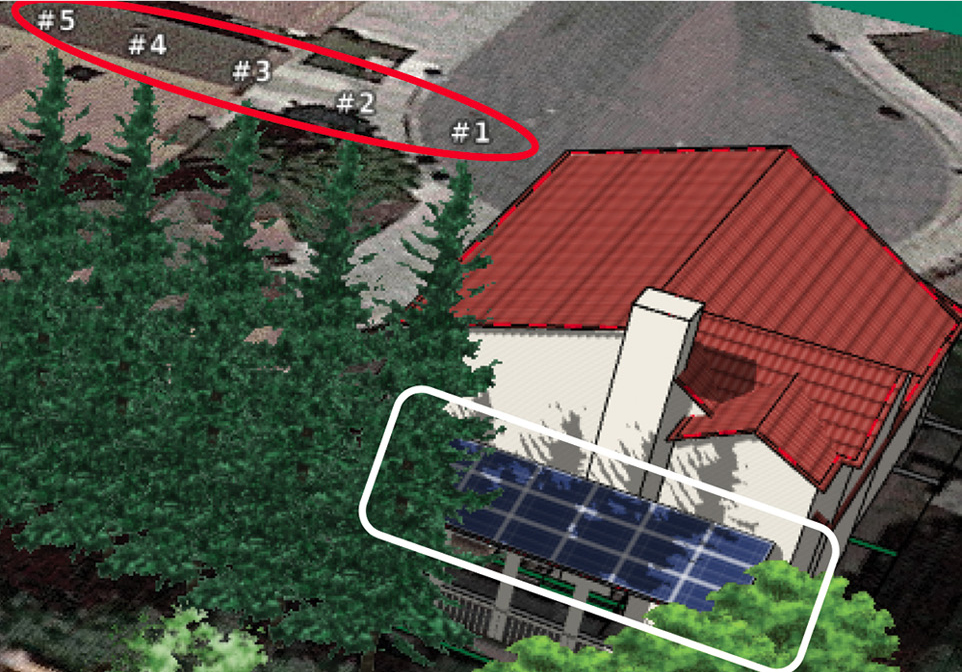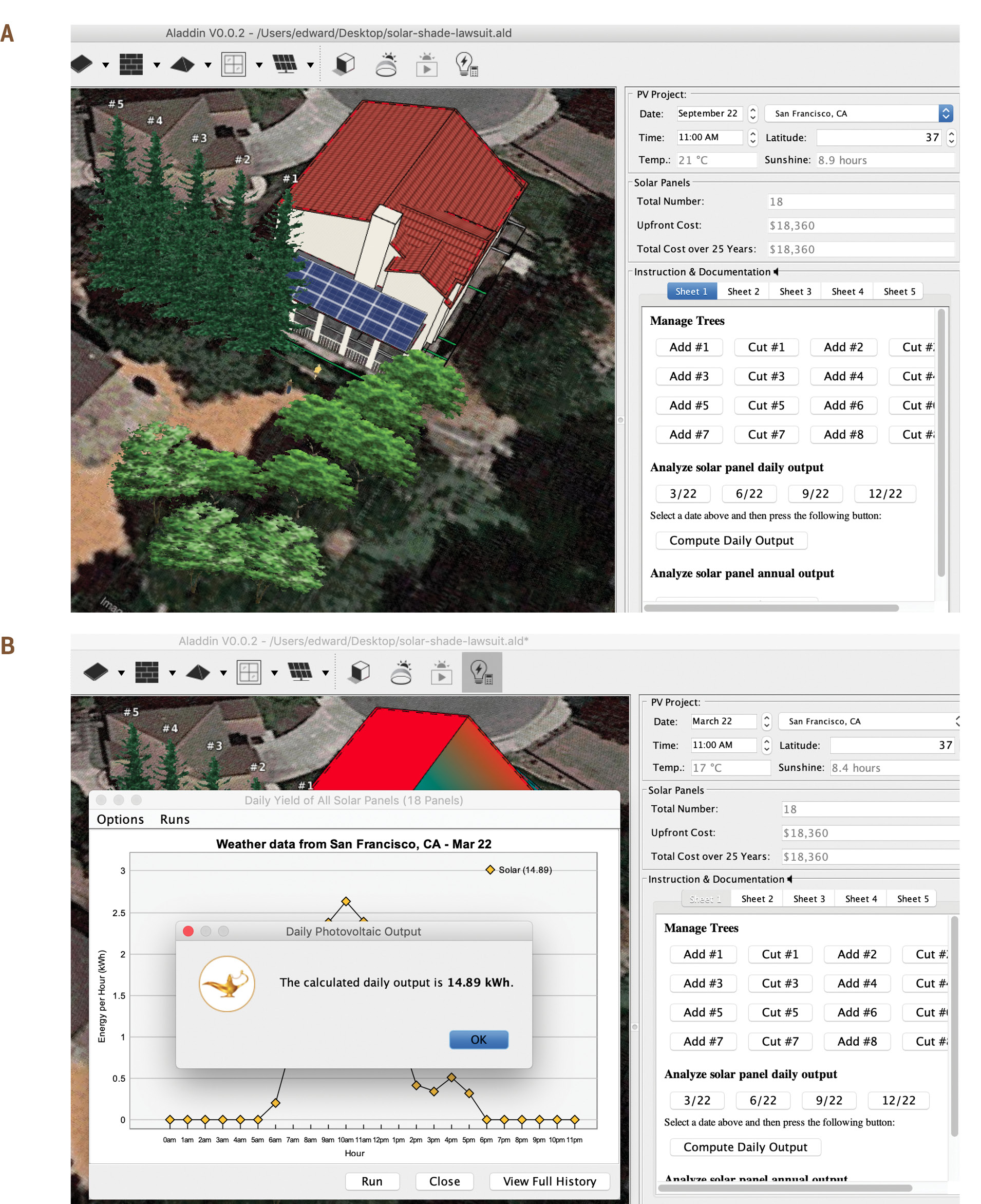feature
Panels v. Trees
Broadening the Pathways of Engineering Education Through Integration With Social Studies
Science Scope—July/August 2022 (Volume 45, Issue 6)
By Shannon Sung, Rundong Jiang, Xudong Huang, and Charles Xie

CONTENT AREA Earth Science/Environmental Science
GRADE LEVEL 6–8
BIG IDEA/UNIT Students will be able to recognize social problems, design possible solutions using simulated data, make informed decisions, formulate persuasive arguments, and respect different ideas in a culturally diverse and democratic society.
ESSENTIAL PRE-EXISTING KNOWLEDGE Students understand that all energy humans use comes from natural resources.
TIME REQUIRED Ten class periods (45-minute per class)
COST No cost
SAFETY No safety issues
Solar Panels v. Trees court case description
In the real court case, the superior court in California convicted the defendant of violating the state’s Solar Shade Control Act (AB 2321), which states: After the installation of a solar collector, a person owning ... another property shall not allow a tree ... to grow on that property so as to cast a shadow greater than 10 percent of the collector absorption area ... The law was enacted in 1978 to protect the rights of solar collector owners, and trees that block the solar panels from the Sun are considered a private nuisance. The plaintiff sued the defendant because he deemed her refusal to remove the redwood trees in the backyard to be breaking the law.
Middle school is a crucial time for developing an interdisciplinary perspective and acquiring critical skills to tackle complex social issues. Students need to recognize social problems, ask valid questions, conduct independent research, design possible solutions, make informed decisions, formulate persuasive arguments, separate evidence from opinions, and respect different ideas in a culturally diverse and democratic society. Both natural science and social science education standards expect students to develop these competencies, and while science teachers are looking for ways to situate engineering education within a broader social context, social studies teachers often need a method for students to collect evidence to support their argumentation.
Solar Panels v. Trees is an activity that integrates engineering education and social studies. In this activity, students participate in a mock trial based on a real court case that involved the impact of trees on solar panel performance, use engineering design software to generate data through simulations, and analyze the data to find evidence to support their arguments during the debate. This case is especially controversial because trees and solar panels can both reduce carbon footprints and mitigate climate change. Similar to trade-offs in engineering practices, students adopt a holistic perspective, consider the interest of multiple stakeholders, and employ evidence-based argumentation to resolve a dispute (Brown et al. 2010; Chan and Forsythe 2020; Osborne, Erduran, and Simon 2004).
In addition to learning the science and engineering of solar energy and the social, economic, and environmental impacts of electricity generation, students use Aladdin, a computer-aided design (CAD) tool to collect evidence for both sides of the mock trial. Aladdin is a cloud-based CAD tool that is freely available online (see Aladdin in Online Resources) and can run on all devices (including Chromebooks, tablets, and iPads, etc.). With Aladdin, students can animate the Sun’s path, display shadows cast on solar panels (such as those made by trees), and add or remove different trees to determine changes in solar energy output. Students use the built-in simulation and analysis tools to gather and process data to be used as evidence for supporting their arguments during the mock trial (see 5-E learning objectives and daily activity outline in Supplemental Materials).
Engage: Introduction to Solar Panels v. Trees
Day 1, approximately 1 class period, 45 minutes
The teacher can show Figure 1 to the students and share an article from The New York Times (Barringer 2008; see link to article in References) that describes how the defendant refused to cut down the redwood trees in her backyard after her neighbor installed solar panels (see Slides in Online Resources). The teacher then introduces the responsibility of each courtroom role that students will play during the mock trial (see Online Table 1). Based on the information from this real-world case, the teacher introduces students to the modified case using the information in the box on page 24 and reads Case Background (see Online Resources).

A Google Maps view of the houses of the defendant (left) and the plaintiff (right).
Explore: Can you see the Sun through the trees?
Days 2–4, approximately 3 class periods, 135 minutes
Each student is assigned to work on a laptop equipped with Aladdin. The teacher places a lamp in the back of the classroom and tells students that the lightbulb represents the Sun, while the front of the classroom indicates north. The teacher then explains common terminologies used to describe the Sun’s locations to help students understand that the Sun changes angles hourly, daily, and seasonally. Students are asked to point their left hands to the ceiling and their right hands to the lamp. They learn that the angle between the two hands represents the zenith angle, and the angle between the right hand and the ground represents the elevation angle (see Figure 2). With this basic knowledge, students open the tutorials in Aladdin and use the heliodon tool to simulate the Sun’s path and examine the daily and seasonal changes of the Sun’s angles. They also observe the seasonal changes of daytime length and the Sun’s path in different parts of the world. Students can discuss findings with each other, but they need to fill out the answer sheet individually. Finally, students engage in an activity, Optimize It (see Online Resources), to see who can generate the highest energy output from one solar panel by changing parameters such as location, tilt angle, azimuth angle, and efficiency (see Figure 3; directions for Optimize It can be found on p. 18 of the Slides in Online Resources). Students’ performance on the Optimize It may be suggestive of their levels of solar energy understanding and can be used as a formative assessment. This activity is self-paced, and the teacher addresses students’ questions and misconceptions during class before proceeding to the mock trial.

Using Aladdin to model the Sun’s location at noon on September 22nd in Boston, MA. Students can use a heliodon to explore the Sun’s path in the sky and the changing solar elevation angle at different times of the day and the seasons in a year. The direction of the Sun can be represented by three angles: zenith angle (Z), elevation angle (h), and azimuth angle (A). The zenith angle is the direction between the Sun and the direction perpendicular to the surface. The elevation angle is complementary to the zenith angle. The azimuth angle is the angle of the Sun relative to the north.

A solar simulation game, Optimize It, allows students to integrate the learned concepts into practice.
Having gained a solid foundation with Aladdin, students are ready to start exploring solutions specific to the court case. Before the court is called into a session, students interact with an Aladdin model of the plaintiff’s solar panels and the defendant’s trees at issue (see Figure 4) to determine whether the trees in the defendant’s backyard lower the energy output of the solar panels by 10% and, if so, which trees cause the most reduction in energy output. Later on, students who play the judge and the jury will need to rule which trees “violate the law” and which ones do not.

Model of the trees at issue (red oval) and the plaintiff’s solar panels (white rectangle) in Aladdin.
The students collect quantitative evidence in preparation for the debate by adding or cutting the trees to simulate the energy output (see Figure 5A). We provide an answer sheet to show the difference between the minimum energy output (i.e., keeping all the trees) and maximum possible output (i.e., removing all the trees at issue). Students plan and carry out investigations in Aladdin (see Solar Concept Answer Sheet and Instructions for Evidence Collection in Online Resources) by analyzing the daily and annual energy outputs (see Figure 5B), learn how to interpret the differences in energy output, and then record the energy outputs into the answer sheet, which helps students document their findings as scientific evidence to be presented to the court.

(A) Aladdin interface allows students to easily remove and add trees to the simulation to calculate the solar panels’ shading and electrical output; (B) student artifact showing the screenshot recording the calculated daily output on March 22
Table 2 shows the work of a student who decided to experiment by cutting Trees #1–5 individually and writing down the annual energy output from each experiment. The difference between the energy output and the maximum output is automatically calculated in the next column and highlighted in green. This student might have noticed that Tree #1 impacts the energy output the most (i.e., Tree #1 casts the most shade and causes the greatest loss when compared with other results in colored cells). Nevertheless, the remaining trees still violate the law because the annual energy output is still reduced by 14%, exceeding the 10% rule. The student continued to experiment by cutting a combination of trees over two additional iterations, both of which included cutting Tree #1 (see colored cells in Online Table 2). Students are encouraged to interpret and use the numbers highlighted in the colored cells as evidence in the upcoming mock trial.
The stage is now set for the trial to begin. Students are assigned courtroom roles and responsibilities from one of four teams: the defendant and attorney, the plaintiff and attorney, the jury, and the judge. The teacher can assign roles randomly, let students choose their own roles, or assign students to roles that best fit their personalities. At this point, students should understand factors that affect the energy output of a solar panel and be able to anticipate potential counterarguments from the other side. A carefully scripted worksheet containing a role assignment chart and directions for writing opening statements, note-taking, and question-posing during the mock trial process (see worksheets for different roles in Online Resources) guides students through the court proceedings. Students are only required to take notes on the worksheet as references for the opening statement, cross-examination, and final argument.
Explain: Building reasonable arguments
Day 5, approximately 1 class period, 45 minutes
To further develop their argumentation skills, students use a Reasoning Skill Coach worksheet (see Online Resources) to practice the four elements of reasoning (purpose, claim, evidence, and inferences). To give specific examples of these four elements, the teacher first shows a pair of men’s ice skates in class, asks students to identify the properties they observe from the ice skates (e.g., size 12, used condition, darker color), and tells students that evidence consists of statements describing the relationship between the observation and data. Then the teacher asks students to infer the possible owner of these ice skates (e.g., an adult male that may be over six feet tall and knows skating) and tells them this is called inference. The teacher continues to introduce the worksheet, which uses an adapted script of a public mock trial of a stolen car case (California Courts n.d.; see adapted script entailed in the Reasoning Skill Coach worksheet in Online Resouces). The Supreme Court of California published this document to promote civic education and notes that the material is “appropriate for middle and high school students” (California Courts n.d., p. 1).
After the teacher reads the opening statements and explains different reasoning skills applied in the script, students continue to work with their team members and discuss the testimony provided by the witness, expert, and defendant. Students individually review the final arguments from both parties’ attorneys and categorize each sentence into one of the four reasoning elements. The teams employ the learned reasoning skills to write their opening statements and formulate questions to help them engage in evidence-based argumentation in the mock trial.
Elaborate: Seeing all the angles
Days 6–9, approximately 3 class periods, 135 minutes
The plaintiff and defendant teams employ reasoning skills to draft their opening statements in shared documents, while the judge and jury teams formulate questions to help them clarify questionable statements and make a justified decision (see sample worksheets for each role in Online Resources). Students continue to work in their teams for about 30 minutes to review the data collected from Days 3–4, carry out more targeted investigations in Aladdin, or collect more evidence to support their claims. Students typically spend more time drawing inferences from the evidence. However, if existing evidence is not strong enough, the students can quickly open the model in Aladdin and run additional simulations and analyses to substantiate the claims. During this 30-minute interval for group work, the teacher circulates among teams to address their questions and facilitate discourses in preparation for the mock trial. The court is called to order with the plaintiff and defendant teams reading their opening statements, after which the judge and jury ask their first round of clarifying questions. Next, the cross-examination begins, with both the plaintiff and defendant teams bringing their experts and witnesses to the stand to testify using scientific evidence obtained from the Aladdin simulations. Typically, the plaintiff teams would use the simulated results to back up their claims by pointing out a violation of the 10% rule, if all five of the violating redwoods were to be kept. The defendant teams often strive to keep as many trees as possible by citing the annual output that abides by the 10% rule. Once both sides have exhausted the evidence for their case and stated their claim, each team presents their final arguments to the judge and jury for the verdict. After careful deliberation, the jury delivers their decision to the judge, who announces the final verdict. After the mock trial, the teacher reveals the result of the real trial, where some trees were deemed “guilty” of blocking the output of the plaintiff’s solar panels and had to be pruned.
Evaluate
Day 10, approximately 1 class period, 45 minutes
Throughout the activity, students fill out a quick emotion diary (see the link in Online Resources) each day, which helps the teacher capture shifts in student attitude. Students’ initial reactions to the curriculum were mixed with positive and negative emotions; however, their attitudes became more positive when the project progresses to a more interactive stage and peaked during cross-examination (76% positive emotions reported in the diary with an average of 69.12% during mock trial sessions). Participants seem to enjoy the mock litigation process more than merely acquiring solar science concepts using Aladdin. Student notes and performance during the mock trial also provide opportunities for formative and summative assessments. The teacher grades students individually based on their overall participation during the mock trials and from their worksheets (see Online Table 3).
The curriculum provides sufficient structure and scaffolding for students to conduct their own investigations and search for potential solutions via Aladdin. Students back up their arguments by evidence from diverse perspectives such as aesthetics, civics, ecology, economics, ethics, finance, and law.
Conclusion
Evidence-based reasoning is an essential skill for both science and social studies—both require students to think critically to discern truth from misinformation. The use of engineering design tools to provide quantitative scientific evidence gives students the ability to apply evidence-based reasoning to socioscientific issues. Students’ emotion diaries also indicated more positive feelings during the mock trial than during direct instruction of solar energy concepts and reasoning skills, demonstrating the power of role-playing in an authentic context to enliven the whole classroom. We found students listened attentively to each speaker and played their roles with confidence during the entire litigation process; even the most reserved students were able to get into character with enthusiasm. In other words, engineering education and social studies both become more engaging for students when they combine to present a promising way to resolve socioscientific issues. Aladdin and its accompanying curriculum materials thus provide an effective activity for bridging engineering education and social studies. •
Acknowledgments
This material is based on work supported by the National Science Foundation #2105695 and #2131097. We are also indebted to Danielle Fredericks and Elena Sereiviene for coordinating the classroom implementations.
Online Resources
Aladdin home page—https://intofuture.org/aladdin.html
Documents for the Solar Panels v. Trees mock trial—https://intofuture.org/aladdin-solar-panels-v-trees.html (scroll down on opening page to locate links for the following: Aladdin Model; Case Background; Defendant Evidence and Argument Preparation Worksheet; Instruction for Evidence Collection; Judge and Court Clerk Evidence Review and Penalty Recommendation; Jury Verdict Form; Plaintiff Evidence and Argument Preparation Worksheet; Reasoning Skill Coach; Reasoning Skill Coach [Teacher Version]; Solar Concepts Answer Sheet; Slides)
Emotion diary—https://bit.ly/3a0MGJf
Optimize It—https://bit.ly/3GElD2F
Supplemental Materials
5-E learning objectives and daily activity outline—https://bit.ly/3tdLTf7
Shannon H. Sung (shannon@intofuture.org) is a Learning Scientist and Director of Assessment and Evaluation, Rundong Jiang is Director of Curriculum and Instruction, Xudong Huang is a Learning Scientist, and Charles Xie is a Chief Scientist, all at the Institute for Future Intelligence in Natick, Massachusetts.
Biology Computer Science Earth & Space Science Interdisciplinary Technology Middle School


